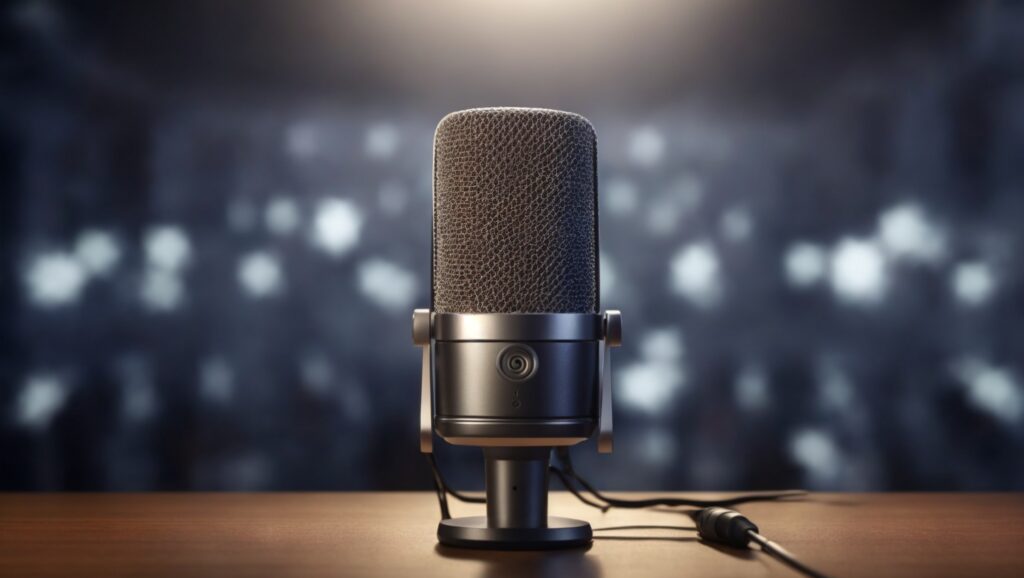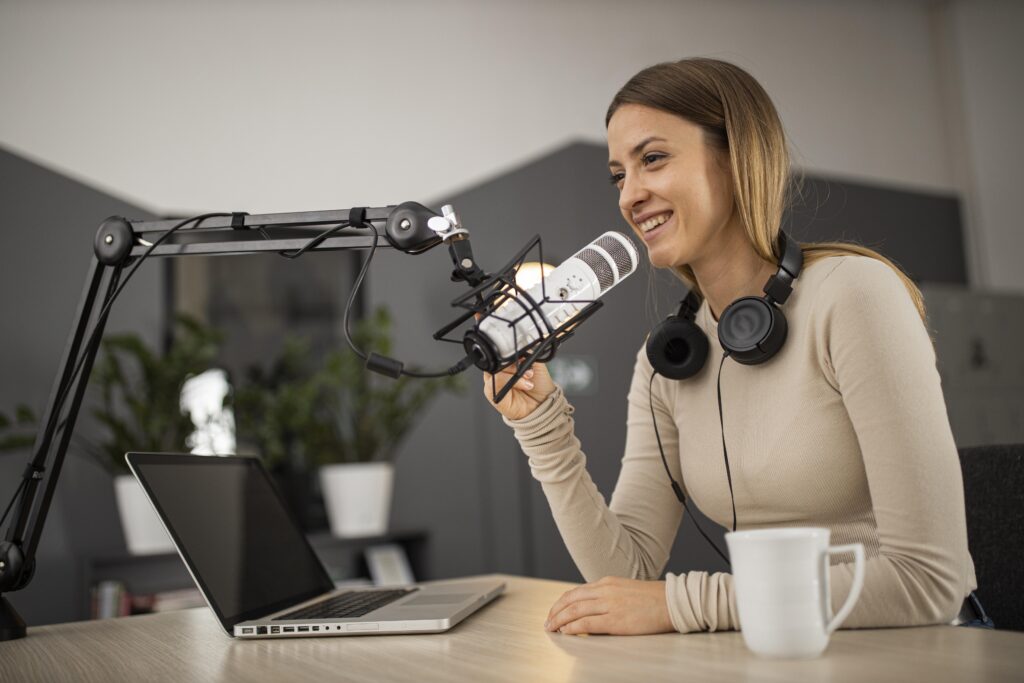Disclaimer: Some links in this article may be affiliate links. These links may earn us a small commission, but rest assured, our reviews are unbiased and not influenced by these affiliations. Your trust is our priority, and we are committed to providing honest assessments of the products we recommend.
Welcome to the epic face-off of the audio world, folks! Imagine if microphones had personalities. Condenser mics would be the suave, sophisticated ones, sipping tea with their pinkies up, while dynamic mics are the tough cookies, ready to rock ‘n’ roll on stage. That’s right, in this corner, we’ve got condenser mics, and in the other corner, dynamic mics.
It’s the ultimate showdown: “Condenser vs Dynamic Mic”! Ding, ding, ding!
Table of Contents
Condenser vs Dynamic Mics: The Two Titans of Sound
Now, picture this: you’re in a recording studio, and you need to pick the perfect mic for your superstar voice. You have two choices – condenser and dynamic mics. It’s like choosing between a sleek sports car and a rugged 4×4 SUV. Both get the job done, but they have different styles.
Condenser mics are the James Bonds of the microphone world. They’re smooth, sensitive, and ready to capture even the tiniest whispers.
Picture them in a tuxedo, sipping on a shaken, not stirred, martini while they capture every nuance of a singer’s voice or the delicate strumming of a guitar string.
These mics work their magic using a thin, sensitive diaphragm that moves when sound waves hit it. It’s like having a super-sensitive radar for sound. However, there’s a catch – they can be a tad delicate and might need a little extra love and care. Also, they usually need some power to do their thing, so you’ll often see them plugged into fancy equipment.
Dynamic microphones are the rock stars of the mic world. They’re the leather jacket-wearing rebels, ready to take a beating and keep on belting out the tunes.
These mics are your go-to choice for live performances, capturing the roar of a guitar amp or the fierce vocals of your favourite rock band.
Dynamic mics work a bit differently. Instead of a sensitive diaphragm, they have a sturdy coil of wire and a magnet inside. When sound waves crash into that coil, it dances within the magnetic field, creating an electric signal. It’s like they have a built-in air guitar solo!
So, here’s where the real fun begins. We’re going to pit these two against each other in the ultimate “Condenser vs Dynamic Mic Showdown.” We’ll compare their sensitivity, durability, and even their price tags. It’s going to be a battle of epic proportions, and by the end, you’ll know which microphone is your audio superhero.
Stay tuned, because this showdown is about to get wild! Condenser mics, get ready to bring your A-game. Dynamic mics, it’s time to rock and roll. Who will be the victor in the ultimate quest for sound supremacy? Let’s find out!
Comparing Condenser and Dynamic Mics: The Ultimate Showdown
Ladies and gentlemen, boys and girls, step right up to witness the most epic microphone showdown of all time: the battle between condenser and dynamic mics! In one corner, we have the suave and sensitive condenser microphones, and in the other, the rugged and robust dynamic microphones. It’s time to compare these two titans of sound and see who comes out on top.
Sensitivity – The Whisper Test
Picture this: you’re in a quiet room, and you want to capture the gentlest whisper. You need a mic that’s as sensitive as a cat’s whiskers. This is where condenser mics shine. They are like the audio ninjas of sensitivity, picking up the faintest sounds with precision.
Condenser mics have that magic diaphragm we talked about earlier. It’s super thin and responsive, like a spider’s web in a gentle breeze. When sound waves approach it, it dances gracefully, capturing every subtle detail. So, if you’re recording delicate vocals, acoustic instruments, or the soothing sounds of nature, a condenser mic is your best friend.
On the other hand, dynamic mics are the strong, silent types. They’re like the bouncers at a rock concert, ready to handle the loudest shouts without breaking a sweat. If you’re standing in front of a massive guitar amp, belting out your favourite rock anthem, a dynamic mic will stand its ground.
The reason for this toughness is the coil and magnet setup. It’s built to withstand high sound pressure levels without flinching. But, and here’s the catch, it won’t capture the whisper-soft details like a condenser mic would. So, choose wisely based on what you need to record.
Durability – The Toughness Test
Now, let’s talk about durability. If you’re a musician on the road or you tend to get a bit wild during your recordings, you’ll want a mic that can handle the action. This is where dynamic microphones strut their stuff.
Imagine you’re performing on stage, the crowd’s going wild, and you accidentally drop the mic (yes, it happens!). A dynamic microphone will probably shrug it off and keep on rocking. Their rugged build can take a beating, making them ideal for live performances and rough handling.
Condenser mics, on the other hand, are a bit more delicate. They’re like fine china in a world of sledgehammers. Drop one, and you might end up with a costly repair bill. These mics are best suited for controlled studio environments where they can be pampered and protected.
Price Tag – The Wallet Test
Let’s talk about money, shall we? We all have budgets to consider, right? When it comes to price, there’s a noticeable difference between condenser and dynamic mics.
Condenser microphones, with their sensitivity and studio-quality performance, often come with a heftier price tag. They’re like the luxury cars of the microphone world. If you’re looking to invest in top-notch audio quality for your recordings, a condenser mic is worth saving up for.
On the flip side, dynamic microphones are more budget-friendly. They provide excellent sound quality without breaking the bank. So, if you’re just starting your audio journey or need a mic for live performances, dynamic mics won’t drain your wallet.
| Feature | Condenser Microphone | Dynamic Microphone |
| Sound Sensitivity | High (captures fine details) | Low (best for loud sounds) |
| Durability | Delicate (handle with care) | Sturdy (can take a beating) |
| Cost | Often more expensive | Budget-friendly |
Condenser vs Dynamic Mics: Factors to Consider
Let’s delve into the factors that will help you make the perfect microphone match.
Purpose – What’s Your Jam?
First things first, think about what you’re going to use your microphone for. Are you a budding musician looking for a way to sing and record your heart out? Maybe you’re a content creator ready to launch your own YouTube channel. Or perhaps you’re a podcaster with a story to tell. Different microphones are suited for different purposes.
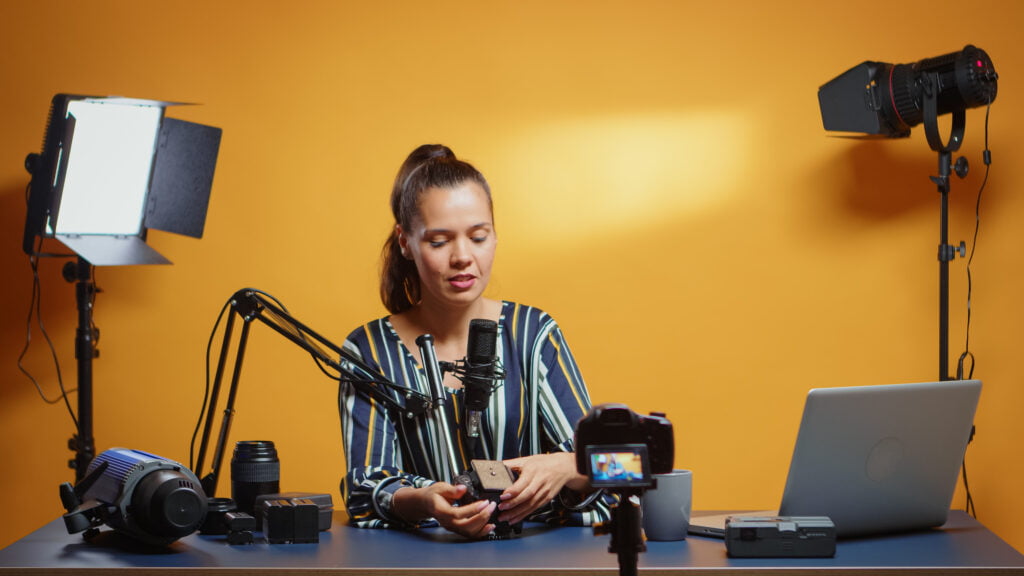
If you’re all about capturing the finer details of sound and you’re working in a controlled environment, like a studio, condenser mics are your buddies. They’re perfect for recording vocals, acoustic instruments, and studio-grade audio.
On the flip side, if you’re out there in the world, performing live gigs, interviewing people on the go, or recording in noisy environments, dynamic microphones are your go-to option. They’re built to handle loud noises and rough handling.
Budget – How Much Can You Swing?
Condenser and dynamic microphones come with different price tags.
Condenser Microphones often lean towards the higher end of the price spectrum. They’re like the top-tier luxury cars of the microphone world. If you’re willing to invest for premium sound quality, save up, and go for it.
On the budget-friendly side, dynamic microphones are your heroes. They offer excellent sound quality without emptying your pockets. If you’re starting your audio journey or need something sturdy for live performances, dynamic mics are your trusty companions.
Environment – Where Will You Rock?
Consider the places where you’ll be using your microphone. Are you in a quiet, controlled studio, or are you facing the chaos of live performances or outdoor recording? The environment plays a significant role in your microphone choice.
Condenser Microphones mics thrive in controlled, quiet settings. If you’re recording in a studio where you can control background noise, a condenser microphone will shine. They’re like the elegant pianos of microphones, best appreciated in serene surroundings.
In noisy, unpredictable environments, dynamic microphones are your rock ‘n’ roll buddies. They can handle the chaos, like a lead guitarist shredding on stage. So, if you’re performing live or recording in bustling places, dynamic mics are your trusty roadies.
Handling and Maintenance – How Much Love and Care Can You Give?
Are you ready to give your microphone some love and care? Different microphones require different levels of attention.
Condenser Microphones are a bit like delicate instruments. They demand gentle handling and care. Dust them off, maintain them spotless, and guard them against jolts and collisions. They’re like the prized violins of microphones.
Dynamic mics are the tough cookies of the microphone world. They can take a bit of rough handling and won’t complain. Just like rock stars, they’re built to withstand the rigours of the road.
Keep these factors in mind, and you’ll be well on your way to picking the perfect microphone companion for your sound journey. Whether you’re in the studio, on the stage, or out in the wild, there’s a microphone waiting to make your voice heard.
Our Recommendations
If you’re ready to make a choice, here are some of our best microphone recommendations from Amazon to get you started:
Condenser Microphone – USB: Blue Yeti
A versatile and high-quality microphone that’s perfect for content creators and podcasters.
Blue Yeti USB
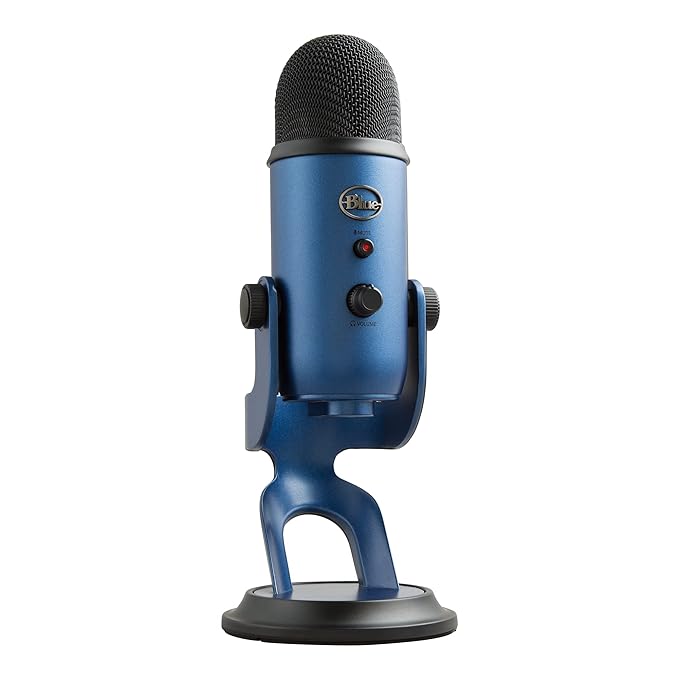
Plug-n-Play Powerhouse
- Versatile: It offers multiple pickup patterns, making it suitable for a wide range of recording scenarios, from solo podcasts to group interviews.
- High-Quality Audio: The Blue Yeti delivers excellent audio quality, capturing clear and detailed sound, making it ideal for professional recordings.
- Plug-and-Play: It’s easy to use—simply plug it into your computer’s USB port, and you’re ready to record without the need for additional audio interfaces or complicated setup.
Condenser Microphone – XLR: Audio-Technica AT2020 Cardioid Condenser Studio XLR Microphone
Ideal for studio recording, this microphone is perfect for you to get started.
Audio-Technica AT2020 XLR

Studio Standards
- Superior Sound Quality: The AT2020 offers outstanding audio clarity and fidelity, making it a popular choice among recording professionals for capturing vocals and instruments with precision.
- Durable Build: This microphone is built to last, with a robust construction that can withstand the rigors of studio use and live performances, ensuring long-term reliability.
- Affordable: The AT2020 provides excellent quality at a budget-friendly price point, making it an accessible option for both beginners and experienced audio enthusiasts.
Dynamic Microphone: Samson Q2U
A robust microphone designed for live performances with excellent sound quality.
Samson Q2U USB/XLR
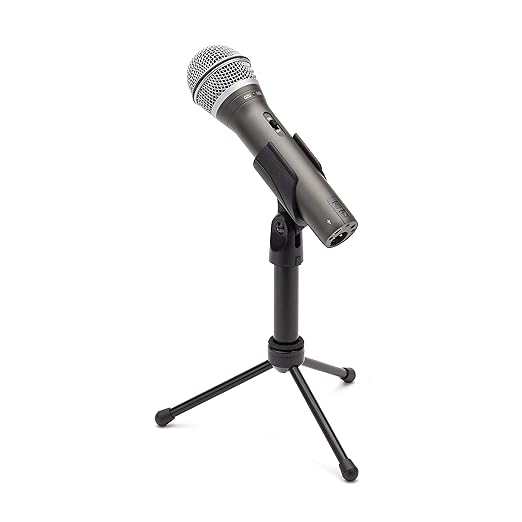
Affordable All Rounder
- Versatile: The Q2U offers both USB and XLR connectivity options, allowing you to use it with a wide range of devices, from computers to audio interfaces, making it incredibly versatile for various recording situations.
- Affordable: It provides excellent audio quality at an affordable price point, making it an excellent choice for budget-conscious podcasters, musicians, and content creators.
- Durable: The Q2U is built to withstand the demands of frequent use, featuring a rugged construction that can handle live performances and on-the-go recording, ensuring long-lasting reliability.
These recommendations can help you kickstart your microphone journey with options that suit your needs and budget.
Tips for Caring for Your Microphone
So, you’ve embarked on your quest to conquer the world of sound with your trusty condenser or dynamic mic. That’s awesome! But, before you ride off into the sunset with your newfound microphone buddy, let’s talk about something crucial: mic care.
Tip #1: Gentle Handling – Be a Mic Whisperer
Now, imagine you’re holding a baby bird. That’s how you should handle your condenser microphone, with all the care in the world. Condenser mics are sensitive souls, and rough handling could make them go “Ahh, I can’t take it anymore!”
One time, I got a fancy condenser mic for recording my music. I was so excited that I practically hugged it. But I soon learned that this mic had a delicate side. It started sounding a bit off, and I realised I had been handling it too roughly. So, remember, gentle is the name of the game with condenser mics!
Tip #2: Keep It Clean – Mic Spa Day
Think of your microphone as a celebrity on the red carpet. It needs to look its best and sound its best too! Dust and dirt can sneak in and mess with your mic’s performance. So, give it a spa day now and then by gently wiping it down with a soft, lint-free cloth.
Tip #3: Storage Matters – A Safe Haven
When your mic isn’t in action, give it a cosy home. A protective case or a mic stand is like a snug blanket for your microphone. It’ll shield it from accidental falls and bumps, and it won’t have to sleep on the cold, hard floor.
Tip #4: Beware of Moisture – Keep It Dry
Water and microphones don’t mix well. So, avoid using your mic in wet conditions, and if it does get a bit damp, make sure it’s completely dry before you use it again. Remember, your mic isn’t a fan of water sports!
Tip #5: Avoid Extreme Temperatures – Mic Spa Retreat
Extreme heat or cold can make your microphone unhappy. It’s like sending it to the sauna or the North Pole – not ideal! Keep your mic in a comfortable, room-temperature environment to keep it performing at its best.
Tip #6: Regular Check-Ups – Mic Doctor
Just like we need check-ups with the doctor, your microphone needs regular inspections too. Listen for any strange noises or changes in sound quality. If something seems off, it might be time for a visit to the mic doctor (or a professional technician) for a check-up.
Tip #7: Use a Pop Filter – No Popping Allowed
Imagine you’re recording a podcast, and every time you say “popcorn,” it sounds like an explosion. Annoying, right? That’s where a pop filter comes in. It’s like a superhero shield against those annoying “pops” in your audio.
Tip #8: Follow the Manufacturer’s Guidelines – Mic Rulebook
Every microphone comes with its own rulebook, or user manual. Make sure to read it! It’s like knowing the rules of the game before you play. The manufacturer’s guidelines will tell you how to set up, use, and maintain your mic properly.
These tips will keep your condenser or dynamic mic in tip-top shape for all your audio quests. Treat your mic right, and it will reward you with crystal-clear sound for years to come.
Frequently Asked Questions (FAQs)
What is the primary difference between condenser and dynamic microphones?
The main difference lies in their sensitivity and durability. Condenser microphones are more sensitive and capture fine details, while dynamic microphones are rugged and excel at handling high sound levels.
Which microphone is better for recording vocals in a studio?
Condenser microphones are typically preferred for studio vocal recordings due to their sensitivity and ability to capture subtle nuances.
Can I use a dynamic microphone for podcasting or voiceovers?
Absolutely! Dynamic microphones are suitable for podcasting and voiceovers, especially if you’re in a noisy environment or have limited budget constraints.
Do condenser microphones require a power source?
Yes, condenser microphones typically need phantom power, supplied by an audio interface or mixer, to operate. Some USB condenser mics have built-in power sources for convenience.
Are dynamic microphones less expensive than condenser microphones?
Yes, in general, dynamic microphones tend to be more budget-friendly compared to condenser microphones, making them a great choice for beginners and cost-conscious users.
Can I use a condenser microphone for live performances?
While it’s possible, condenser microphones are more suited for controlled studio environments. Dynamic microphones are usually preferred for live performances due to their durability and noise rejection.
What should I consider when choosing between these microphones?
Consider your purpose (studio recording, live performances, podcasting), budget, the recording environment, and the level of care you can provide for your microphone. These factors will guide your choice.
How can I clean and maintain my microphone?
Clean your microphone gently with a soft, lint-free cloth, and store it in a protective case when not in use. Avoid exposing it to moisture or extreme temperatures.
Condenser vs Dynamic mic – which is best gaming and streaming?
Both types of microphones can be used for gaming and streaming. Your choice depends on your specific setup and sound preferences.
The Verdict – Who Wins the Showdown?
So, who takes the crown in the “Condenser vs. Dynamic Mic Showdown”? Well, there’s no one-size-fits-all answer. It all boils down to your specific needs and preferences.
If you’re in a controlled environment, recording delicate sounds, and you’re willing to invest in top-tier audio quality, a condenser microphone might be your best bet.
On the other hand, if you’re a performer, a podcaster, or simply looking for a durable, budget-friendly option, dynamic microphones are your go-to choice.
In the end, it’s not about which microphone is better; it’s about which one suits your unique needs. Both condenser and dynamic mics have their strengths and weaknesses, and they’re ready to help you capture the sounds that matter to you.
So, the next time you’re faced with the “Condenser vs. Dynamic Mic” dilemma, consider your environment, the type of sounds you’ll be recording, and your budget. Armed with this knowledge, you’ll be ready to choose the perfect microphone for your audio adventures.
Now, let the sound adventures begin! Whether you’re whispering sweet melodies or rocking the stage, you’ve got the mic knowledge to make your voice heard.
Disclaimer: Some links in this article may be affiliate links. These links may earn us a small commission, but rest assured, our reviews are unbiased and not influenced by these affiliations. Your trust is our priority, and we are committed to providing honest assessments of the products we recommend.
